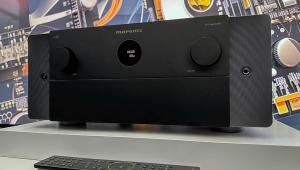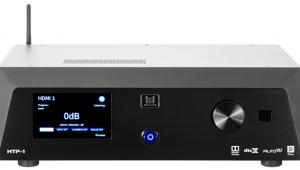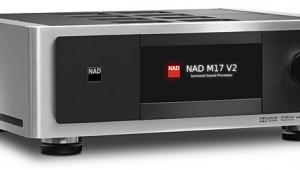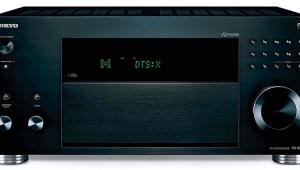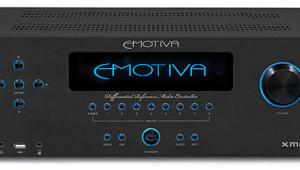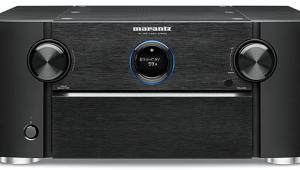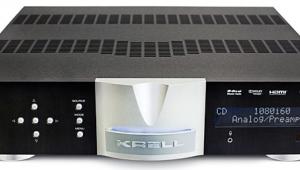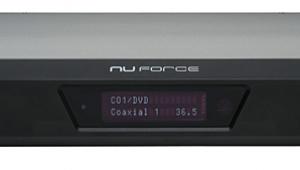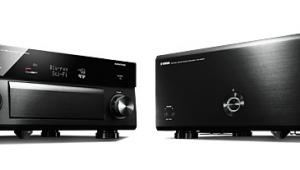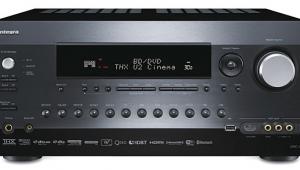Marantz AV8802 Surround Processor Review Page 2
 Another Format War?
Another Format War?
Dolby isn’t the only company out there promoting new audio formats that make use of overhead height channels. Along with Atmos, Auro-3D was also well received at last September’s CEDIA Expo, and as I write this, DTS’s answer to the object-based Atmos system, DTS:X, is said to be nearing introduction. Marantz, in an unusually thorough commitment to future-proofness, has you covered on all three fronts. The AV8802 ships with Atmos capabilities, and an Auro-3D firmware upgrade costs $199. The company also told us that, before the end of 2015, a DTS:X update will be available (no decision has been made about whether this will be free or incur a nominal charge). What’s more, while Atmos and Auro-3D, at least, normally require you to commit in advance to different speaker locations for some of the surround channels, Marantz plans to mitigate this by allowing a unified speaker layout for all three formats, letting you switch easily among them to accommodate different software. Format war? Not with the AV8802.
Look Out Above!
My audio system consists of three M&K S150 speakers across the front, four SS150 surround speakers mounted approximately 6.5 feet from the floor (not conforming to Dolby’s recommendations for Atmos, but I own them and there’s no other way to place them in my living space), four Atlantic Technology IC-6-OBA in-ceiling speakers for Atmos height duties, and dual subwoofers—a Hsu Research VTF-15 MK2 and an SVS PC-Ultra. Amplification is provided by a Parasound Halo A 51 for the three front speakers and L/R surrounds, with a Parasound ZoneMaster 1250 bridged to six channels for the rear surrounds and four Atmos overhead speakers.
When I finally got to audition Atmos-enabled discs at home, I found that they really help draw you into the film much more than I had anticipated. In The Hunger Games: Mockingjay, Part 1, the Capitol has grown tired of District 13’s rebellious ways and decides to bomb its citizens into submission. We’re taken into the command center of the district as the explosions begin, and wowza!—your fight-or-flight instincts will have you ducking for cover as the roof seems ready to cave in. This is just one of many scenes that make great use of the additional channels.
Unfortunately, the number of Atmos-enabled titles on Blu-ray can still be counted on two hands—and the number of really high-caliber movies for the moment is limited to a couple of fingers. But thankfully, Dolby has a new derived-surround algorithm—Dolby Surround Upmixer (DSU)—which allows you to take full advantage of your Atmos-enabled system with traditional channel-based audio tracks. The additional speakers definitely add to the atmosphere of movies. For example, there’s a scene in Captain Phillips where pirates storm a container ship. The only way the ship can defend itself is with fire hoses (talk about taking a knife to a gun fight!), and when the camera switches to the perspective of the pirates, the Atmos overhead speakers come into play and add to that feeling of the water coming down on you—a fact I verified by manually turning off the amp supplying power to the overhead speakers to gauge the effect. My only gripe with the upmixing was that there was some occasional score bleed to the front ceiling speakers that could overpower the dialogue, but this might have been because the front overhead speakers were set a tad hot by Audyssey. (Dolby needs to release test tones on their demo discs.)
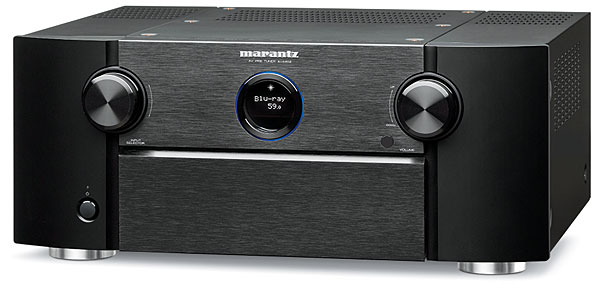
While I was wowed and amazed by Atmos and DSU on movies, the two-channel performance of the AV8802 is what really blew me away. The hardware upgrades done by the Marantz engineers revealed themselves in critical listening tests. The soundstage is deeper and wider, and voices are crisper and clearer when compared with my AV8801. I recently had a Krell Foundation pre/pro in my rack, which was head and shoulders better than the AV8801 on two-channel listening, but the AV8802 has closed the gap considerably in this regard (at only two-thirds the price of the $6,500 Krell).
This superb audio quality came to light on the song “Second Choice,” from the Marti Jones album Live at Spirit Square. It features a bass guitar, some bongo drums, and Jones’ fabulous voice. The bass is tight, and the layered track transports you directly to the live performance. The Marantz picked up the subtle aspects of the recording, such as the bassist’s fingers sliding along the strings. This has become one of the first audio recordings I use to test out new gear, and the AV8802 definitely made it shine.
Conclusion
I could wax poetic about the prowess of the AV8802 for several more paragraphs, but alas, the dreaded word count has caught up with me. After experiencing Atmos in my home, I have to admit: There’s no way I can ever go back to a conventional five- or seven-channel system. Furthermore, when the considerable improvement in two-channel performance is factored in, this is an easy upgrade to consider. In fact, the AV8802 would be my first choice for our Top Pick of the Year, and it will be tough to knock off its perch as the rest of 2015 plays out. Highly recommended.
